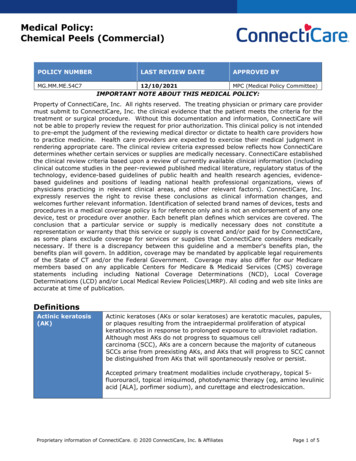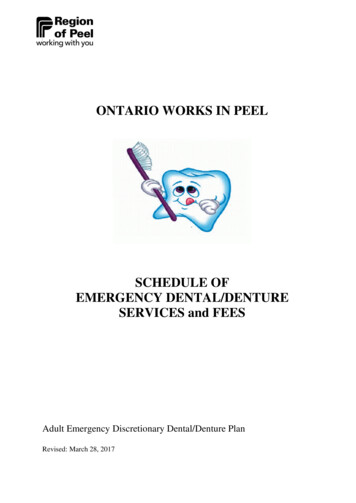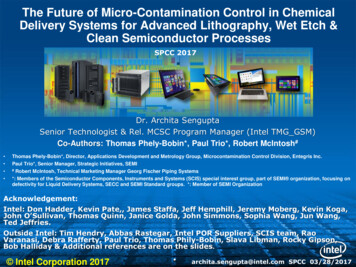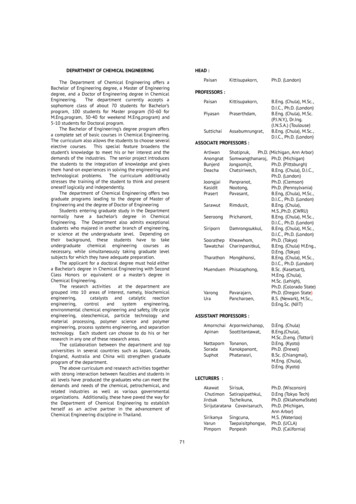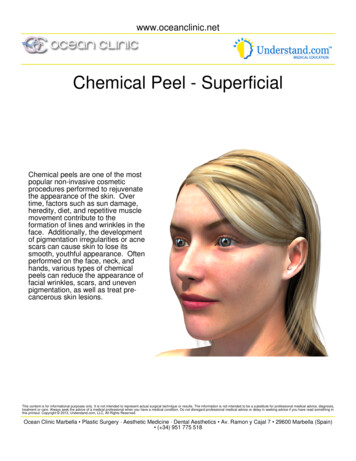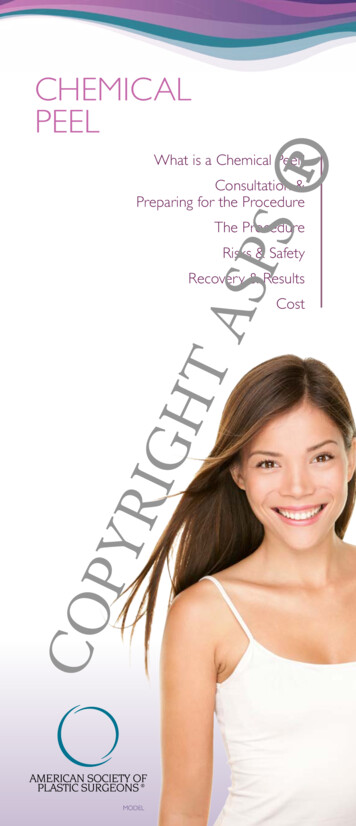
Transcription
CHEMICALPEELWhat is a Chemical Peel?Consultation &Preparing for the ProcedureASPSThe ProcedureRisks & SafetyRecovery & ResultsCOPYRIGHTCostMODEL
WHAT IS ACHEMICAL PEEL?TASPSCOPYRA chemical peel can help improve: Acne or acne scars Age and liver spots Fine lines and wrinkles Freckles Irregular skin pigmentation Rough skin and scaly patches Scars Sun-damaged skinYou may not be a good candidate for chemical peelingif you have: A history of abnormal skin scarring Abnormal pigmentation Afro-Caribbean or Asian skin Facial warts Red hair and pale freckled skin Used certain acne treatments within thelast yearIGHA chemical peel is one of the least invasive waysto improve the appearance of your skin. Sunexposure, acne, or just getting older can leave yourskin tone uneven, wrinkled, spotted, or scarred.A chemical peel can help your skin look smootherand younger. It uses a chemical solution to smooththe texture of your skin by removing the damagedouter layers. Although chemical peels are usedmostly on the face, they can also be used toimprove the skin on your neck and hands.A chemical peel cannot: Treat deep facial lines Tighten loose or sagging skin Remove broken capillaries Change pore size Remove deep scarsMODEL23
THE PROCEDUREDuring your consultation be prepared to discuss: Your goals Medical conditions, drug allergies, andmedical treatments, smoking history Current medications, vitamins, herbalsupplements, alcohol, tobacco, and drug use Previous surgeriesLight chemical peel:Subtle improvements at first, but that healthy glowwill increase with more treatments.If you have uneven pigment, dryness, acne, or finewrinkling, a light chemical peel might be the rightchoice. This kind of peel removes just the outerlayer of skin (epidermis) in a light exfoliation andresults in a healthier glow. Your health care providerwill use a combination of alphahydroxy acids andbeta hydroxy acids, such as glycolic acid, lactic acid,salicylic acid, and maleic acid. All of these chemicalsare the mildest choices. You can repeat thesetreatments to achieve your desired results.IGHTYour surgeon will also: Evaluate your general health status and anypre-existing health conditions or risk factors Discuss likely outcomes and any risks orpotential complicationsChemical solutions are carefully applied to yourskin to improve the texture by removing damagedouter layers. The chemicals used are phenol,trichloroacetic acid, and alphahydroxy acids. Theformula used by your doctor will be adjusted tomeet your particular needs.ASPSCONSULTATION& PREPARING FORTHE PROCEDURECOPYRBe sure to ask your plastic surgeon questions.It’s very important to understand all aspectsof your chemical peel. It’s natural to feel someanxiety, whether it’s excitement for youranticipated new look or a bit of stress. Don’tbe shy about discussing these feelings withyour plastic surgeon.4Procedural Steps: Your face will be cleansed. The chemical solution is brushed onto yourskin and left on for a few minutes. You may feelsome mild stinging. The chemical peel is then washed offand neutralized.5
THE PROCEDURE(Continued)Deep chemical peel:Results are dramatic, but recovery takes the longest.RIGHAcne scars, deeper wrinkles and uneven skincolor can all be treated with a medium chemicalpeel. The chemicals used for this type of peel willremove skin cells from both the outer layer of skin(epidermis) and upper part of your middle layerof skin (dermis). Your health care provider will usetrichloroacetic acid, sometimes used in combinationwith glycolic acid.If you have deeper facial wrinkles, skin that’sdamaged by the sun, scars, areas that appearblotchy, or even pre-cancerous growths, deep facialchemical peels might be the right choice for you.Your physician will use the strongest chemical calledphenol to penetrate down to the lower dermallayer of your skin. For this type of peel, you mayneed a local anesthetic and a sedative to manageany discomfort.TASPSMedium chemical peel:Your skin will be noticeably smoother andfresher-looking.COPYProcedural Steps: Your face will be cleansed. The chemical solution is brushed onto yourskin and left for just a few minutes. You mayfeel some burning or stinging. The treated area may turn a whitish grey color. The chemicals are neutralized with a coolsaline compress. Your skin may turn red or brown in the daysjust after the peel. It may take up to six weeksfor your skin to look normal.A deep chemical peel usually involves some sortof pretreatment for up to eight weeks. This willprepare your skin for the peel and speed thehealing process. Pretreatment may include useof a retinoic acid cream or gel – a prescriptionmedication that’s derived from vitamin A. Thisworks to thin out the skin’s surface layer, allowingthe chemical solution to penetrate more evenly anddeeply.You may repeat a medium chemical peel every fewmonths to maintain your new glowing skin.67
THE PROCEDURERISKS & SAFETYProcedural Steps: You will be given a sedative to relax along witha local anesthetic to numb your face. Your face will be cleansed. Phenol is brushed onto the area after anappropriate time interval. The chemical is neutralized with water. A thick coat of ointment is smoothed overyour skin, to prevent dryness and pain. Theointment must stay in place. Sometimes yoursurgeon will cover your skin with strips of tapeor medicated gauze rather than ointment.You should understand that all chemical peels carrysome risks and uncertainties. It’s usually a verysafe procedure when performed by a qualifiedand experienced plastic surgeon. It happensinfrequently, but you could develop an infection orscarring from chemical peels.For people with certain skin types, there is a riskof developing a temporary or permanent colorchange in the skin either lightening or darkening.Use of hormone medications or a family history ofbrownish discoloration on the face may increasethe possibility of developing abnormal pigmentation.If you have suffered from cold sores (herpes) inthe past, there is a risk of reactivation. Be sure toask your doctor to prescribe medication to try andavoid an outbreak.COPYRIGHDeep chemical facial peels will result in peeling,crusting, skin redness, and discomfort for severaldays. Your doctor will provide painkillers to keepyou comfortable. Although the swelling is likelyto disappear in about two weeks, your skin mayremain red for up to three months.TASPS(Continued)One treatment with a deep chemical peel willproduce long-lasting and dramatic results that canlast up to 10 years.Inform your physician if you have a history ofkeloids (scar tissue overgrowth) or any unusualscarring tendencies.MODEL89
RECOVERY &RESULTSOther risks include: Hyperpigmentation (when too much pigmentoccurs, causing brown blotches). Avoid this byalways using a high-factor sunscreen. Infection.COPYRIGHMedium chemical peel:When trichloroacetic acid is used in a mediumchemical peel, you’ll experience some redness,stinging, and skin crusting just like a light chemicalpeel. And although these chemicals won’t bleachyour skin, you may see some color changes.You’re advised to avoid the sun for severalmonths to protect that fresh new layer of skin.Deep chemical peel:The chemical used for this kind of peel, phenol, canlighten the skin that’s treated. With this kind of peel,your new skin often loses its ability to makepigment, meaning to tan. You will always need toprotect your skin from the sun. Phenol also canpose a special risk for people with heart disease.Be sure to tell your surgeon about any heartproblems and include it in your medical history.A deep chemical peel requires that you have anadequate recovery time. You may return to workand some of your normal activities two weeks aftertreatment. At that point, your skin will be healedenough for you to wear makeup.TASPSLight chemical peel:You are likely to experience some redness, stinging,skin flaking, and irritation from a light chemical peel.After repeated treatments, these side effects willlikely subside.Other risks include: Hyperpigmentation (when too much pigmentoccurs, causing brown blotches) may resulteven if you use sunscreen. Permanent scarring is another infrequent risk. Redness, which occurs in everyone after thepeel, may last longer than a few months forsome people.10MODEL11
COSTBe sure to ask your surgeon about all costsinvolved in your procedure.ASPSRIGYour satisfaction involves more than a fee:When choosing a plastic surgeon, remember thatthe surgeon’s experience and your comfort withhim or her are just as important as the final costof the surgery.COPYPlastic surgery involves many choices. The first andmost important is selecting an American Societyof Plastic Surgeons (ASPS) member you can trust.ASPS member surgeons are board certified by theAmerican Board of Plastic Surgery (ABPS). ASPSmember surgeons meet rigorous standards: Board certification by the American Boardof Plastic Surgery (ABPS) or in Canada byThe Royal College of Physicians and Surgeonsof Canada 12 Complete at least six years of surgical trainingfollowing medical school with a minimum ofthree years of plastic surgery residency training Complete continuing medical education,including patient safety each year Perform surgery in accredited, state-licensed,or Medicare-certified surgical facilitiesDo not be confused by other official soundingboards and certifications.The ABPS is recognized by the American Board ofMedical Specialties (ABMS), which has approvedmedical specialty boards since 1934. There is noABMS recognized certifying board with “cosmeticsurgery” in its name. By choosing a member ofThe American Society of Plastic Surgeons, you canbe assured that you are choosing a qualified, highlytrained plastic surgeon who is board-certified bythe ABPS or The Royal College of Physicians andSurgeons of Canada.HTPrices for elective procedures can vary. The costfor a chemical peel may be based on the expertiseand qualifications of the person performing theprocedure, type of chemical peel performed, timeand effort the procedure or treatment requires,and the geographic location of the office. Manyplastic surgeons offer patient financing plans, so besure to ask. Additional fees may include: Anesthesia fees Prescriptions for medication Facility costsThis brochure is intended strictly for educational purposes. It is notintended to make any representations or warranties about the outcome of any procedure. It is not a substitute for a thorough, in-personconsultation with a board certified plastic surgeon.13
QUESTIONS TO ASKMY PLASTIC SURGEONUse this checklist as a guide during your consultationAre you certified by the American Board ofPlastic Surgery?Am I a good candidate for a chemical peel?What will be expected of me to get the bestresults?Have they been specifically trained in thisprocedure?Where and how will you perform myprocedure or treatment?IGHWho will perform the chemical peel?TASPSIs the office-based surgical facility accreditedby a nationally or state-recognized accreditingagency, or is it state-licensed orMedicare-certified?Notes:COPYRHow long of a recovery period can I expect?What are the risks and possible complicationsassociated with my procedure?How can I expect to look over time?Do you have before-and-after photos I can lookat for this procedure?What results are reasonable for me?1415
ASPSRIGHTThe Symbol of Excellencein Plastic Surgery COPYAMERICAN SOCIETY OF PLASTIC SURGEONS444 East Algonquin RoadArlington Heights, Illinois 60005-4664(847) 228-9900PlasticSurgery.orgConnect with us on Facebook,Twitter, and m/asps newspinterest.com/asps newsThe American Society of Plastic Surgeons (ASPS ) is dedicated toadvancing quality care in plastic surgery by encouraging high standardsin training, ethics, physician practice, research, and continuing medicaleducation. ASPS members are certified by The American Board of PlasticSurgery (ABPS) in The United States and its territories or The RoyalCollege of Physicians and Surgeons of Canada . 2015 American Society of Plastic Surgeons . All rights reserved.Reorder # 1518 1015
for a chemical peel may be based on the expertise and qualifications of the person performing the procedure, type of chemical peel performed, time and effort the procedure or treatment requires, and the geographic location of the office. Many plastic surgeons offer patient financing plans, so be sure to ask. Additional fees may include:
